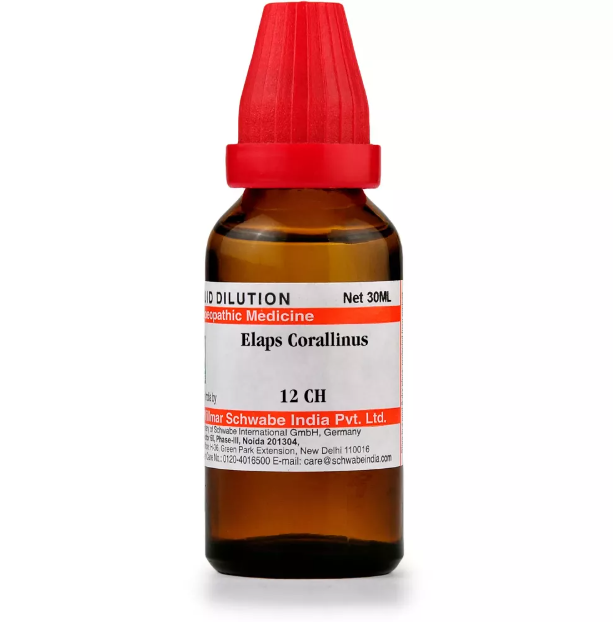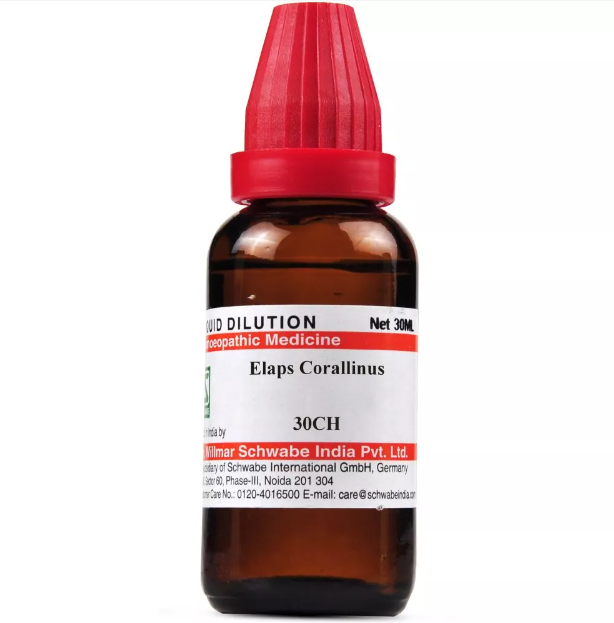ELAPS CORALLINUS 6C, 12C, 30C, 200C, 1M, 10M USES AND SYMPTOMS
 ELAPS CORALLINUS
ELAPS CORALLINUS
(Coral Snake)
Elaps.
Similar to other snake poisons. Notable for black discharges. Cold things disagree. Craves sweetened buttermilk. Experiences nausea, vomiting, and severe diarrhea. Stomach acidity with faintness. Sudden stomach pain. Esophagus spasms; pharynx tightens; food and liquids stop suddenly, then drop heavily into the stomach. Spasms followed by weakness. Cold stomach feeling. Fruits and ice water feel very cold. Right-sided paralysis. Needs oscillatory motion. Rheumatic tendencies. Important ear, nose, and throat symptoms.
Mind: Depressed; imagines hearing voices; fears being alone. Fear of rain. Can speak but cannot understand speech. Fears apoplexy.
Head: Violent headache from forehead to back of head; affects one eye, then the other. Earache. Vertigo with a tendency to fall forward. Head feels heavy and painful.
Eyes: Photophobia; letters blur when reading. Veil over eyes. Burning eyelids. Morning eyelid edema. Large red spots before eyes.
Ears: Hard, black earwax, hearing difficulty; offensive greenish discharge; buzzing and auditory illusions. Sudden night deafness with roaring and crackling sounds. Intolerable ear itching.
Nose: Chronic nasal catarrh with fetid odor and greenish crusts. Yellow-green discharge. Wrinkled mucous membrane; dry mucus plugs nostrils. Pain from nose to ears when swallowing. Nostrils blocked. Nosebleeds. Pain at the nose root. Eruptions around the nose.
Throat: Thick, very offensive, dry greenish-yellow crusts on the back of the throat; foul breath. Esophagus spasms; fluids stop in passage.
Stomach: Cold feeling. Sensation of food turning like a corkscrew when swallowing; craves sweetened buttermilk. Acidity after every bite.
Female: Painful menstruation with black blood. Black blood discharge between periods. Itching of vulva and vagina.
Chest: Cold chest after drinking. Lung hemorrhage, black and watery like ink; right lung apex stitches. Fainting when stooping. Oppression when climbing stairs. Peeling skin on palms and fingers. Painful cough. Worse on right side with black blood expectoration. Esophagus feels like a sponge.
Extremities: Icy cold feet. Vesicular eruptions on feet. Swollen, bluish arms and hands. Sprained knee joint sensation. Pricking under nails.
Sleep: Dreams of dead people.
Fever: Cold sweat all over. Typhoid with tissue ulcers and black blood discharge.
Skin: Affected glands and axillae skin; itching with tetter. Peeling finger tips. Itchy eruptions in axillae.
Modalities: Worse with fruit, cold drinks, wet weather.
Relationship: Compare: Kino (hemoptysis and intestinal hemorrhage), Eucalyptus rostrata (offensive dark right ear discharge), Crot-h., Alumn., Carb-v., Ars., Lach.
Dose: Sixth to thirtieth potency.
SYMPTOMS OF ELAPS CORALLINUS
Mind:
Depression
Imagines hearing voices
Fear of being alone
Fear of rain
Can speak but cannot understand speech
Fear of apoplexy
Head:
Violent headache from forehead to back of head; affects one eye, then the other
Earache
Vertigo with a tendency to fall forward
Heavy, painful head
Eyes:
Photophobia
Letters blur when reading
Veil over eyes
Burning eyelids
Morning eyelid edema
Large red spots before eyes
Ears:
Hard, black earwax, hearing difficulty
Offensive greenish discharge
Buzzing and auditory illusions
Sudden night deafness with roaring and crackling sounds
Intolerable ear itching
Nose:
Chronic nasal catarrh with fetid odor and greenish crusts
Yellow-green discharge
Wrinkled mucous membrane
Dry mucus plugs nostrils
Pain from nose to ears when swallowing
Blocked nostrils
Nosebleeds
Pain at the nose root
Eruptions around the nose
Throat:
Thick, very offensive, dry greenish-yellow crusts on the back of the throat
Foul breath
Esophagus spasms; fluids stop in passage
Stomach:
Cold feeling
Sensation of food turning like a corkscrew when swallowing
Craves sweetened buttermilk
Acidity after every bite
Female:
Painful menstruation with black blood
Black blood discharge between periods
Itching of vulva and vagina
Chest:
Cold chest after drinking
Lung hemorrhage, black and watery like ink
Stitches in the right lung apex
Fainting when stooping
Oppression when climbing stairs
Peeling skin on palms and fingers
Painful cough
Worse on right side with black blood expectoration
Esophagus feels like a sponge
Extremities:
Icy cold feet
Vesicular eruptions on feet
Swollen, bluish arms and hands
Sprained knee joint sensation
Pricking under nails
Sleep:
Dreams of dead people
Fever:
Cold sweat all over
Typhoid with tissue ulcers and black blood discharge
Skin:
Affected glands and axillae skin
Itching with tetter
Peeling finger tips
Itchy eruptions in axillae
Modalities:
Worse with fruit, cold drinks, and wet weather
selection of the potency
Individualization:
- Homeopathy is based on the principle of treating the individual, not just the disease. The unique symptoms and characteristics of the person are crucial in determining the most suitable potency.
Intensity of Symptoms:
- The intensity of the symptoms guides the choice of potency. If the symptoms are intense and acute, a lower potency (e.g., 6C, 30C) might be considered. For chronic conditions with less intensity, higher potencies (e.g., 200C, 1M) may be appropriate.
Sensitivity of the Patient:
- Some individuals are more sensitive to homeopathic remedies, while others may require higher potencies. The practitioner considers the patient’s sensitivity when selecting the potency.
Acute vs. Chronic Conditions:
- Lower potencies are often used for acute conditions, while higher potencies may be considered for chronic or long-standing issues.
Previous Response to Potencies:
- The patient’s response to previous homeopathic treatments helps guide the choice of potency. If a particular potency has been effective in the past, it may be repeated or adjusted as needed.
Vital Force and Susceptibility:
- Homeopathy views illness as a disturbance in the vital force. The practitioner assesses the patient’s overall vitality and susceptibility to determine the appropriate potency.
Aggravation or Amelioration:
- The direction of the symptom response (aggravation or amelioration) after taking a remedy can influence the choice of potency.
Miasmatic Considerations:
- In classical homeopathy, the concept of miasms (inherited disease tendencies) is considered. The practitioner take this into account when selecting the potency.
Practitioner Experience:
- The experience and preference of the homeopathic practitioner play a role. Some practitioners may have success with certain potencies based on their clinical experience.
SAFETY INFORMATION
- Do not exceed the recommended dose by physician
- Keep out of the reach of children
- Store in a cool dry place away from direct sunlight
- Maintain half an hour gap between food/drink/any other medicines and homoeopathic medicine
- Avoid any strong smell in the mouth while taking medicine e.g. camphor, garlic, onion, coffee, hing
Medicine images use for reference only selection of homeopathic medicine depends on the individual’s specific symptoms and overall constitution. Moreover, homeopathy is a holistic system of medicine that treats the individual as a whole. In addition to addressing the physical symptoms, it takes into account the emotional and mental state of the person. Consequently, it’s crucial to consult with a qualified homeopathic practitioner for personalized treatment.
The information provided on this website is intended solely for educational purposes. Always seek the advice of your physician or other qualified health provider.
